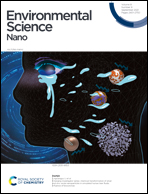Understanding the toxicity mechanism of CuO nanoparticles: the intracellular view of exposed earthworm cells†
Abstract
Copper oxide nanoparticles (CuO NPs) are widely used in industry. Once released, they can enter the soil system and endanger organisms living in this environment. Therefore, monitoring the NP impact on soil organisms and identification of suitable biomarkers associated with NP pollution are required. In this study, immune effector cells of the earthworm Eisenia andrei, amoebocytes, were exposed to environmentally relevant sublethal concentrations of CuO NPs (1, 10, and 100 μg mL−1 of Cu) and their impact on the cellular and subcellular levels, as well as on the mRNA levels of molecules involved in the defense reactions, was assessed in vitro. CuO NPs decreased the viability of both amoebocyte subpopulations by 40% at the highest concentration tested (100 μg mL−1 of Cu). Further, CuO NPs caused significant attenuation of the phagocytic function of hyaline amoebocytes after 6 and 24 hours of exposure, by 37 and 25%, respectively. The concentration of the lipid peroxidation subproduct, malondialdehyde, was 10 times elevated in cells exposed to CuO NPs (100 μg mL−1 of Cu) after 6 hours of exposure. We hypothesize that malondialdehyde may induce DNA breaks, cell cycle arrest, and subsequent cell death. Electron microscopy showed the interaction between CuO NPs and immune effector cells, amoebocytes. Moreover, aggregates of CuO NPs were shown to be engulfed and located in the cytoplasm of these cells. However, data from all experiments indicate that the observed effects of CuO NPs on earthworm coelomocytes were caused mainly by the dissolved Cu2+ ions derived from nanoparticles (NPs). The determination of effective parameters such as oxidative stress, immune reactivity, and genotoxicity would provide valuable comprehension and data for environmental assessment of NP impact on soil organisms.



 Please wait while we load your content...
Please wait while we load your content...